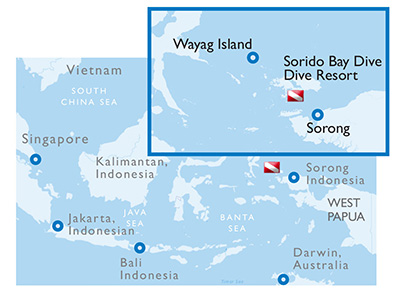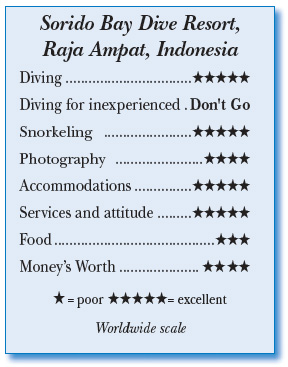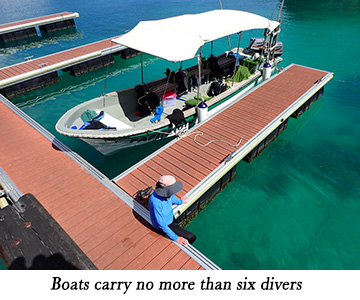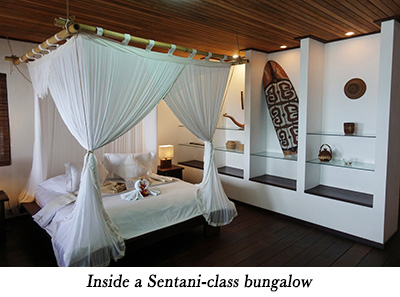Sorido Bay Dive Resort, Raja Ampat, IndonesiaContents of this Issue: Sorido Bay Dive Resort, Raja Ampat, Indonesia Jellyfish Mucus Found to be a Cause of Sea Itch Is that Aquarium Coral Farmed or Wild Coral? You Can’t Tell Socorro Aggressor, Revillagigedo Islands, Mexico Those Full-face Snorkeling Masks – More to the Story Goliath Groupers: Better in the Water than on the Plate How Much “Fat Shaming” Is There in Diving? Your Reader Reports are the lifeblood of Undercurrent Why You Need Medical Evacuation Insurance Coronavirus – Will it Affect Your Dive Travel Plans? Editorial Office: Ben Davison Publisher and Editor Undercurrent 3020 Bridgeway, Suite 102 Sausalito, CA 94965 luxury in the heart of a fabled dive region from the March, 2020 issue of Undercurrent
Dear Fellow Diver: The last thing I would expect in such pristine waters as those of Raja Ampat was to learn of a manta entangled in a fishing net, but a researcher at the resort, Dr. Phil Dustan, came back from his morning dives with photos of an encumbered manta. At Phil's urging, we turned our afternoon dive into a rescue mission, hoping to free the manta from its potential death trap and returned to where Phil saw it, hoping that after a few hours, it might still be around. At Manta Slope, we spotted two mantas circling around a large coral head, but nowhere could we spot the victim. I wondered how difficult it would be to get close to a manta in the tough currents, and if we did, would it sense our purpose and cooperate? I would never know, as we ended the dive disappointed we could not carry out a rescue, but deeply appreciative of the opportunity to dive this remarkable area.
It took me almost three days in December, with overnights in LA and Jakarta, to reach eastern Indonesia and Sorido Bay. After landing in Sorong at 6:30 a.m., it was a 90-minute boat ride to Kri Island. The dozen black-tipped reef sharks swimming with parrotfish and trevallies in the aquamarine shallows surrounding the jetty told me that, no, I wasn't in Kansas anymore. The two Swiss couples on the boat and my spouse and I walked up to the open-air dining area, where we sipped fruit drinks while listening to an overview of the resort by the general manager, Christopher Harvey. Originally from South Africa, but has been in Indonesia for many years, including a stint managing the dive resort Wakatobi, the lean thirty-something, who looked like he could be a Navy SEAL, was engaged to Jade Rondonuwu, the resort's Indonesian co-manager, whose beautiful personality matched her outward appearance. After checking our C-cards and number of dives, Chris explained the personalized dive routine, which included posting the daily dive schedule next to our dining area. Boats carried no more than six divers and a captain, with two guides plus a separate guide for any snorkelers. I had the same boat and guide for my entire stay. I lucked out; Chris assigned my buddy and me our own guide. Boats embarked at 8:30, 11 and 3 p.m. My guides always helped us analyze and record the nitrox, set up and carry gear, change tanks, and rinse and store gear in the covered open platform. Kri Island relies on rainwater collected in cisterns, so the need to conserve water meant the wash tanks got brackish.
Long ago, Seventh Day Adventists arrived here; there's no boat diving between 6:30 p.m. Friday and 6:30 p.m. Saturday,. The bowl-shaped house reef, dubbed The Blue Hole, a bit over 60 feet deep, has plenty of unique animals. I spotted a whip goby, a large turtle, and had several first sightings, such as a black and white banded humbug damselfish and a stunning orange spine unicorn fish, the stripes on its face reminding me of war paint. When standing on the dock, the bowl looked small enough for an easy scuba circumnavigation, but appearances were deceiving, and I got a lesson in why the rule of thirds -- turn back after you burn the first third of your tank -- is such a valuable one. About 40 minutes into the dive, with visibility 30-40 feet, I could see the bottom, but there was no sign of home base in my horizontal sightline. When my buddy signaled he was getting low on air, we spy hopped to get our bearings. To my surprise (and chagrin as an experienced diver who should have known better), we were on the opposite side of the bowl from the dock, hundreds of yards away. It was a long surface swim back. Had there been current, getting back might have been impossible.
During my stay, I mingled with the resort's conservation-minded Dutch owner, Max Ammer, who reminded me of Paul Theroux's engaging protagonist in his novel, The Mosquito Coast. What can you say about a guy who built and runs two resorts, heads up a nonprofit marine research center, builds his own dive boats, and flies his own helicopter? The diving guests were a delightful mix from Europe, the U.S., Australia, South Africa, and Malaysia. Among them was Dr. Phil Dustan, a biologist affiliated with National Geographic who won an Emmy for his role in the film, Chasing Coral. The family-style seating at one long table at breakfast, lunch, and dinner provided lots of time for some interesting conversations. One topic: the serious threats from the growing tourism in Raja Ampat, including the pollution that is building despite the strong currents that sweep the islands. Served from a buffet, breakfast began at 7 a.m., with choices including chicken sausages, eggs, cold grilled cheese sandwiches, yogurt, cereals, and fresh juices. Entrees at our hearty lunches and dinners varied between beef, fish, and chicken, tempeh and tofu dishes plus rice and vegetables such as spinach, carrots, and green beans. Soups varied daily, as did the desserts at dinner. Our meals were attended by our gracious Papuan servers, Getsia and Orpa. Everything seemed to be conscientiously prepared, wholesome and healthy, not too spicy or fatty, though each day's dishes often seemed a bit like the others. Nights were quiet at Sorido Bay, but the days were filled with diving and special excursions, as well as additional twilight Mandarin fish dives, blackwater, and fluo night dives. For the fluorescent dive, I strapped on Papua Diving's special amber mask filter, and that caused certain coral and fish to appear in reds, yellows, and greens against the dark backdrop of everything that didn't fluoresce.
To board the dive boats, one had to climb down ladders mounted to the side of the pier (possibly a difficult task for some.)Yahya, my Papuan dive guide in his early 30s, took great care of me and my gear. My boat, the Julia, was a 10-meter-long speed boat with benches and a canvas canopy, with tiller steering for the two outboards that sometimes needed attention to get them running smoothly. There was no marine head. Most divers took off all their gear before climbing the portable ladder to board. Travel time to most dive sites was 15 to 20 minutes. Throughout the week, dive after dive unfolded with great variety, often with a hint of excitement when an occasional black or white tip reef shark ambled past. Having been charged and fin-butted by titan triggerfish in the past, the harlequin and titan triggerfish I saw almost every day jangled my senses. Luckily, they weren't nesting and minded their own business. I feasted my eyes on cuttlefish protecting eggs, yellow fusiliers galore, batfish, pygmy seahorse, leather coral, anemone fish on most every dive, thousands of golden sweepers, garden and moray eels, and batfish; where do I stop? At South Kri, the water dropped to 78F (other sites were in the low 80s), making me glad I was wearing my full 3ml wetsuit plus a hooded tunic. We had a fast drift dive, hitting a number of haloclines and thermoclines. On the way back after one dive, I noticed the high-pressure hose to my gauge was leaking. I figured the slow leak would be no problem for one more dive so after lunch and headed out again. I turned on my air. The blow out was swift. Rather than inconvenience my dive buddies, we kept going around the point to our last dive of the day, Cape Kri. There, I had to content myself with snorkeling one of the most famous dive sites in the world. I could have rented a wrist computer and analog pressure gauge at lunch. Was it worth it to lose the dive, but save some bucks? Doh!
Summing up, I'd have to say that Sorido Bay offer spacious bungalows and a friendly atmosphere in the heart of one of the best dive spots on the planet. From there, you can reach wonderful sites in the eastern Raja Ampat region such as Fam Island and take an excursion all around Gam Island without the downsides of life on a liveaboard knowing that each time you flush the toilet, it is not endangering the marine life. The magic of being able to witness a flight of mantas on one dive and a huge school of humphead wrasse on another, swimming over bed after bed of hard and soft coral, made the journey worth the effort. PS: In the last issue, John and Ben wrote about the travails of being on a dive trip with ill guests, and sure enough, a couple of guests arrived with flu-like symptoms and were so ill they skipped meals for their entire stay, except once. The night they came to dinner, I enjoyed a delightful conversation with them, and not long after, I developed a nasty cough that kept me up through the night. I started a course of some pretty strong antibiotics the next day; as luck would have it, I recovered almost completely within about a day. If guests that ill were to arrive at any resort now, I'm sure everyone would run for cover. -- V.P. Our undercover diver's bio: "I've been diving for more than three decades, logging over 1,000 dives, starting in the Caribbean, California and the Pacific Northwest before switching over to Malaysia, Indonesia and the Philippines. I'm a published amateur underwater photographer, but I still have a long bucket list to check off, and at this point I'm thinking what many of us may feel: So many great dive sites, so little time!"
|

I want to get all the stories! Tell me how I can become an Undercurrent Online Member and get online access to all the articles of Undercurrent as well as thousands of first hand reports on dive operations world-wide
| Home | Online Members Area | My Account |
Login
|
Join
|
| Travel Index |
Dive Resort & Liveaboard Reviews
|
Featured Reports
|
Recent
Issues
|
Back Issues
|
|
Dive Gear
Index
|
Health/Safety Index
|
Environment & Misc.
Index
|
Seasonal Planner
|
Blogs
|
Free Articles
|
Book Picks
|
News
|
|
Special Offers
|
RSS
|
FAQ
|
About Us
|
Contact Us
|
Links
|
3020 Bridgeway, Ste 102, Sausalito, Ca 94965
All rights reserved.

 Indeed, these are remarkable waters and surely a manta haven. On our last day of diving, three Swiss divers and I set out on a day-long excursion around Gam Island through a beautiful passage filled with Karst formations jutting from the sea. En route to Manta Ridge, we were swept along by a strong current until we found a place to hook off. Shortly, one, then two, then three mantas appeared overhead. More joined and my Tokina 10-17 captured eight of these huge animals in one
image as they slowly swam circles
around us in the plankton-filled
waters.
Indeed, these are remarkable waters and surely a manta haven. On our last day of diving, three Swiss divers and I set out on a day-long excursion around Gam Island through a beautiful passage filled with Karst formations jutting from the sea. En route to Manta Ridge, we were swept along by a strong current until we found a place to hook off. Shortly, one, then two, then three mantas appeared overhead. More joined and my Tokina 10-17 captured eight of these huge animals in one
image as they slowly swam circles
around us in the plankton-filled
waters. My first full diving day, I hit the water at
Sawandarek, where I finned past a huge green sea
turtle resting on the bottom, the first of many I
would see. A few minutes later, a football-sized
cuttlefish probed the water with its tentacles. I
passed a common clownfish ("Nemo"), then a beautiful
red carnation tree soft coral and a bluestriped,
silvery gilled nudibranch. After a school of ribbon sweetlips, hundreds
of blue-striped, five-lined, and long spot snapper swimming over a large bed
of huge round, white-fringed plate coral confirmed for me Raja Ampat's splendid
reputation.
My first full diving day, I hit the water at
Sawandarek, where I finned past a huge green sea
turtle resting on the bottom, the first of many I
would see. A few minutes later, a football-sized
cuttlefish probed the water with its tentacles. I
passed a common clownfish ("Nemo"), then a beautiful
red carnation tree soft coral and a bluestriped,
silvery gilled nudibranch. After a school of ribbon sweetlips, hundreds
of blue-striped, five-lined, and long spot snapper swimming over a large bed
of huge round, white-fringed plate coral confirmed for me Raja Ampat's splendid
reputation. I stayed in one of the five Sentani-class double occupancy bungalows; two others held four people. All had AC (although the days were in the mid-80s, a light breeze made it pleasant in the shade), Wi-Fi, and glass windows (no screens, but also no real bug issues after dark). The doors opened onto a large deck that faced Gam Island; at low tide, we had a white sandy beach; at high tide, the water washed our deck steps. At almost 600 square feet and decorated with Papuan artifacts, even penis sheaths, the bungalow was superb. The room was decked out with a comfy king-sized bed draped with mosquito netting, a couch, coffee table, writing desk and chair, plus nightstands and bed lights. It featured a safe and a refrigerator stocked with treats (including beer). A long countertop for camera gear contained a sink and spray nozzle to rinse my housing. Potable water was stored in a couple of containers, one with a hot/cold spigot next to a tray of instant coffees, cappuccino, and teas. White walls separated the main room from the bathroom, which had two sinks (non-potable water), a large shower, and, in a separate room, the flush toilet. And -- wow factor alert -- drop dirty clothes into the laundry basket for free laundry!
I stayed in one of the five Sentani-class double occupancy bungalows; two others held four people. All had AC (although the days were in the mid-80s, a light breeze made it pleasant in the shade), Wi-Fi, and glass windows (no screens, but also no real bug issues after dark). The doors opened onto a large deck that faced Gam Island; at low tide, we had a white sandy beach; at high tide, the water washed our deck steps. At almost 600 square feet and decorated with Papuan artifacts, even penis sheaths, the bungalow was superb. The room was decked out with a comfy king-sized bed draped with mosquito netting, a couch, coffee table, writing desk and chair, plus nightstands and bed lights. It featured a safe and a refrigerator stocked with treats (including beer). A long countertop for camera gear contained a sink and spray nozzle to rinse my housing. Potable water was stored in a couple of containers, one with a hot/cold spigot next to a tray of instant coffees, cappuccino, and teas. White walls separated the main room from the bathroom, which had two sinks (non-potable water), a large shower, and, in a separate room, the flush toilet. And -- wow factor alert -- drop dirty clothes into the laundry basket for free laundry! When it comes to the diving, there were no restrictions other than the maximum 32 percent nitrox depth of 121 feet. Most dives were drifts between 60 and 90 feet, lasting 50 to 60 minutes. But currents were frequent. On one dive, I was swept off the reef and into the blue as I tried to reposition myself on the reef (indeed, no place for macro). Most of the time, we finished off in shallow water to burn off nitrogen.
When it comes to the diving, there were no restrictions other than the maximum 32 percent nitrox depth of 121 feet. Most dives were drifts between 60 and 90 feet, lasting 50 to 60 minutes. But currents were frequent. On one dive, I was swept off the reef and into the blue as I tried to reposition myself on the reef (indeed, no place for macro). Most of the time, we finished off in shallow water to burn off nitrogen. A couple of times, the top of the water column was filled with mild stinging jellyfish. Welts on my spouse's wrists, face, and hands made her glad she could cover up with a hood, full wetsuit, and gloves.
A couple of times, the top of the water column was filled with mild stinging jellyfish. Welts on my spouse's wrists, face, and hands made her glad she could cover up with a hood, full wetsuit, and gloves. Diver's Compass: My 10-night stay came to $7,729 for my (non-diving) spouse and me, which included all meals and unlimited diving with nitrox; extras included the birdwatching excursion ($25), a day trip to Fam Island ($83), my fluoro dive ($65) and Marine Park fee ($72) alcoholic beverages (Bintang at $4.35; Jacob's Creek Shiraz at $49 per bottle . . . tips were suggested at 10 percent of our bill, put in a shared envelope . . . Current was 220-volt in 2-pin outlets; adapters were available . . . The nearest chamber is in Waisai and usually does not have a diving doctor there to operate it. The nearest DAN recommended chamber is in Manado, North Sulawesi . . . Lion Air has heavy excess baggage fees; for four 40-lb. suitcases, ours ran $300; you need local currency . . . I used the Bandara International Hotel in Jakarta and the Sorong Swiss-Belhotel; both were fine and close to the airports. . . U.S. dollars and credit cards were accepted . . . Bluewater Dive Travel put my package together with patience and expertise . . .
Diver's Compass: My 10-night stay came to $7,729 for my (non-diving) spouse and me, which included all meals and unlimited diving with nitrox; extras included the birdwatching excursion ($25), a day trip to Fam Island ($83), my fluoro dive ($65) and Marine Park fee ($72) alcoholic beverages (Bintang at $4.35; Jacob's Creek Shiraz at $49 per bottle . . . tips were suggested at 10 percent of our bill, put in a shared envelope . . . Current was 220-volt in 2-pin outlets; adapters were available . . . The nearest chamber is in Waisai and usually does not have a diving doctor there to operate it. The nearest DAN recommended chamber is in Manado, North Sulawesi . . . Lion Air has heavy excess baggage fees; for four 40-lb. suitcases, ours ran $300; you need local currency . . . I used the Bandara International Hotel in Jakarta and the Sorong Swiss-Belhotel; both were fine and close to the airports. . . U.S. dollars and credit cards were accepted . . . Bluewater Dive Travel put my package together with patience and expertise . . . 